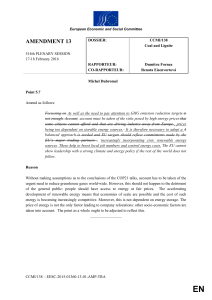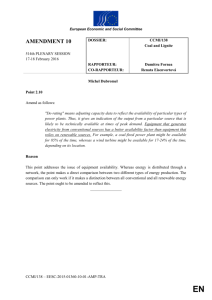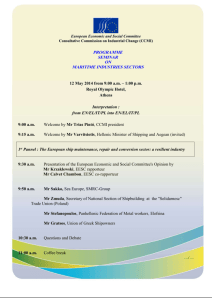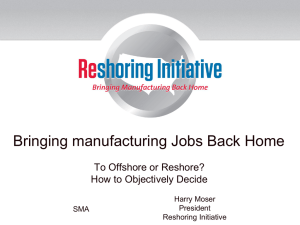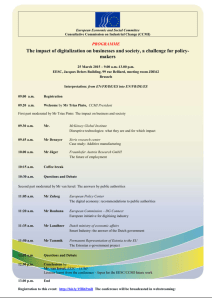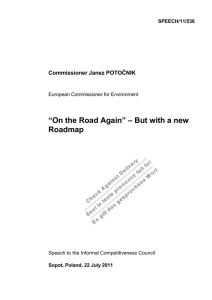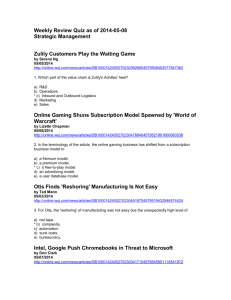3. European industrial policy and reindustrialisation
advertisement
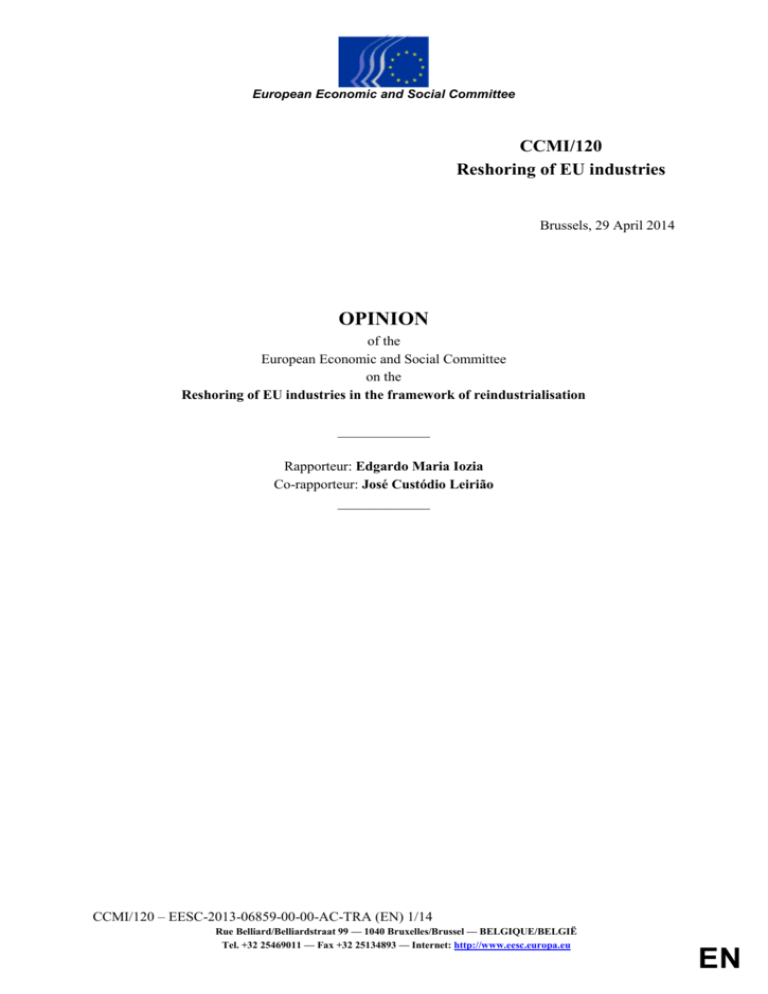
European Economic and Social Committee CCMI/120 Reshoring of EU industries Brussels, 29 April 2014 OPINION of the European Economic and Social Committee on the Reshoring of EU industries in the framework of reindustrialisation _____________ Rapporteur: Edgardo Maria Iozia Co-rapporteur: José Custódio Leirião _____________ CCMI/120 – EESC-2013-06859-00-00-AC-TRA (EN) 1/14 Rue Belliard/Belliardstraat 99 — 1040 Bruxelles/Brussel — BELGIQUE/BELGIË Tel. +32 25469011 — Fax +32 25134893 — Internet: http://www.eesc.europa.eu EN On 19 September 2013, the European Economic and Social Committee, acting under Rule 29(2) of its Rules of Procedure, decided to draw up an own-initiative opinion on the Reshoring of EU industries in the framework of reindustrialisation. The Consultative Commission on Industrial Change, which was responsible for preparing the Committee's work on the subject, adopted its opinion on 8 April 2014. At its 498th plenary session, held on 29 and 30 April 2014 (meeting of 29 April), the European Economic and Social Committee adopted the following opinion by 139 votes with 4 abstentions. * * * 1. Conclusions and recommendations 1.1 The EESC is convinced that in order to halt the EU's economic decline, new impetus must be given to industry, and manufacturing in particular, one of the strong points of the production system. In this own-initiative opinion, the Committee sets out to identify a number of instruments that could prove useful in supporting the European Commission's initiative to reindustrialise the European Union, one aspect of which being the reshoring of businesses that have transferred their activities elsewhere. The Commission has also embarked on an analysis of the subject of reshoring. The Committee welcomes the fact that, in parallel with the drafting of this opinion, Eurofound has been tasked with assembling the set of data needed to understand the extent of the phenomenon of reshoring, and devising possible solutions. 1.2 The Committee supports the plan proposed by the Commission vice-president Mr Tajani to develop a reindustrialisation policy for the EU, bringing industry's share of EU GDP back up to at least 20% from the current 15.1%, and suggests that he extend and strengthen his project, turning it into a "social compact for Europe for a new sustainable and competitive industry". In its recent communication1 the Commission set out a number of priorities, including: 1 deepening the mainstreaming of industrial competitiveness, paying particular attention to productivity in business services to increase industrial competitiveness and the competitiveness of the EU economy in general; maximising the potential of the internal market by developing the necessary infrastructure, offering a stable and simplified regulatory framework; and COM(2014) 14 final. CCMI/120 – EESC-2013-06859-00-00-AC-TRA (EN) 2/14 1.3 acting to decisively implement the regional development instruments in combination with national and EU instruments in support of innovation, skills and entrepreneurship. The EESC would call on the EU to establish a European action plan on these issues, and would make the following specific recommendations: design policies to step up innovation and productivity so as to create a competitive advantage; identify new banking facilities to ease access to funding and speed up the necessary investments; promote measures to secure the participation of Europe's manufacturing industries at all stages of the value chain; ensure that reindustrialisation and reshoring are built into a sustainable European industrial policy that is focused on investment, technology, enterprise, education, innovation, research, energy prices, infrastructure, trade, etc.; provide for consistent, stable and secure regulation; secure the effective functioning of the internal market; ensure that environmental legislation is consistent with European industry's competitiveness and investment cycles; upgrade the relevant infrastructure; provide funding for companies' needs; support European energy policy; secure skilled employment in the European market; and tackle the lack of capacity and skills in the manufacturing industry; establish a system for effectively managing human resources, promoting vocational activity and competences and innovativeness, and in particular making use of the creative potential of civil society bodies such as national and European associations of scientific and engineering personnel. The EESC would call on the Member States to: 1.4 build new industrial districts and facilities or revitalise existing ones that have reduced their activity as a result of the offshoring of manufacturing industries; update or renew production tools and processes to bring them in line with the new requirements of sustainable development policy; establish a more balanced and stable taxation system to promote domestic consumption and attract foreign direct investment; and organise special information centres focused on the offshoring and reshoring processes. The Committee deems it vital to achieve an integrated industrial policy with clearer objectives at EU, national, regional and local levels that is able to attract investment in all sectors of CCMI/120 – EESC-2013-06859-00-00-AC-TRA (EN) 3/14 manufacturing (high and low-tech). These policies should be focused on the global value chain and include research, innovation and development activities. 1.5 The Committee is convinced that it is essential to set ambitious yet realistic targets for the reindustrialisation of Europe to be achieved by 2020. Against this backdrop, policies that promote the reshoring of production activities that were previously offshored could help to achieve the proposed objectives. 1.6 The main reasons for reshoring from China to the West can be summarised as follows: the costs of offshore operations can be higher than forecast; the increased productivity, cost reductions and enhanced capacity that many domestic Western companies have achieved by pursuing continuous improvement programmes; a desire to localise production and design so as to enable better coordination at domestic level; the increasing complexity of products and the need to modify packaging to meet customer preferences; the reduction in energy costs in the USA; stronger government growth initiatives in the USA; the need to over-produce in order to fill containers; products held up owing to uncertain delivery, inconsistent quality, customs procedures; increased transport costs owing to half-empty ships; the high level of inventory required to cope with goods in transit, cycles, safety stock, uncertain delivery times and quality controls; an increase in exceptional costs; a higher incidence of defects compared to local sources, additional inspection of materials and tolerance, more dissatisfied customers; the reduction in the cost gap between the host and home countries (labour and transport costs); operating elements such as: reduced operational flexibility, purchase orders, rigidity postdelivery, penalties for delayed orders; orders that must be of a minimum quantity owing to the size of the container; reduced response to customer demand because of the physical separation between production and development centres; production and delivery; impact on the product lifespan; an increase in the costs of coordinating the supply chain; quality problems (poor quality of products); availability of skills (shortage of well-trained technicians and skilled workers in the host country); high unemployment levels in the home country; and exchange rate risks. CCMI/120 – EESC-2013-06859-00-00-AC-TRA (EN) 4/14 1.7 The manufacturing industries require reliable and flexible supplies in order to compete in today's markets. The reshoring of production is one of the paths that can be taken by companies to meet these needs. In the Committee's view, there should be a focus on the following key policy areas to support manufacturing industries that decide to reshore and/or expand their business in Europe: creating the right environment for companies that invest, professional skills, competitive energy costs, access to funding and market access. 1.8 According to the Commission, "EU retail electricity prices for industry grew on average by 3.5% a year and gas prices 1% between 2008 and 2012. As a result, EU industrial electricity prices are estimated to be twice higher than in the USA and Russia and 20% higher than in China according to the International Energy Agency data2. The price gap is greater in gas: in the EU, gas is three to four times more expensive for EU industry than for US, Russian and Indian competitors, 12% more expensive than in China but cheaper than in Japan. Nevertheless, the prices effectively paid by industrial users may vary from one Member State to another." 3 1.9 The EESC has looked carefully at the issue of energy-intensive industries in Europe4 and has proposed a series of measures and recommendations to enable them to continue producing in Europe. On this occasion, too, it reiterates its call to the European institutions to put in place a common energy policy and to tackle the problem of competitiveness of capital and energy as factors of production. It calls on the social partners to strengthen their cooperation in a development pact that takes into account the characteristics and safeguarding of the European social model, which guarantees the achievement of the Lisbon Treaty objectives concerning a social market economy. 1.10 Consistency between policies has significant implications. The first is that future growth lies in the shift to a low-carbon economy, which in turn calls for consistency between research, legislation and support programmes. The second concerns socially sustainable development and therefore the relationship between competitiveness and employment – i.e. skilled, inclusive jobs for all that can in turn generate good-quality growth and thus added value in terms of competitiveness. 1.11 The Committee believes that a better relationship between companies and banks, focused on the real economy, could generate fruitful synergies and harness the competitive advantages connected to their presence on foreign markets. 1.12 European companies should focus primarily on innovation and on the quality, reliability, performance and functionality of their products; they must consider their environmental 2 3 4 These prices are not corrected by quality differences, as EU electricity supply is more reliable with fewer cuts than in these countries. COM(2014) 14 final. ces1857-2011_ac_en.do. CCMI/120 – EESC-2013-06859-00-00-AC-TRA (EN) 5/14 footprint and aspire to corporate social responsibility in their production processes. However, for companies to remain competitive, it is also essential to keep cost factors under control – especially wage and energy costs – and to put in place requisite measure to that end. 1.13 The transition of our productive, infrastructure and economic systems towards sustainability and demographic change, the training of the new generations and the adaptation of Europe's workforce to the international division of labour all require massive investment if they are to be achieved in a consistent and coordinated manner at European level. 1.14 Retaining a wide and diverse manufacturing base in Europe is important for preserving skills that once lost will be difficult to redevelop. In a broader context, specific manufacturing skills in particular industries could provide important input for the development of new products. 1.15 Europe's capabilities in research and innovation should be strengthened and maintained to ensure sustainable, stable and lasting growth, and to this end, smart, efficient and effective rules are needed to foster the optimum conditions, drive our technological leadership, create quality jobs in research, innovation and manufacturing, and promote security and sustainability5. Companies considering offshoring need to know what they are looking for and how it can be achieved within the EU. They need access to reliable data, information and advice in order to foresee the advantages and disadvantages of such a move, including the real costs. The representatives of the EU and the Member States in the major countries should step up their assistance, as should local and regional authorities. The aim of all of this is to ascertain whether the same objective could be achieved within the EU. 1.16 The main reasons prompting reshoring are set out in point 1.6. 1.17 The Committee is glad to see that the European Commission is including the reshoring process on the industrial agenda as a catalyst for industrial activity and job creation, and feels that it should make manufacturing the driving force of Europe's future. The agreement recently concluded with Eurofound is a modest first step in the right direction. 2. Introduction 2.1 "We cannot continue to let our industry leave Europe. Our figures are crystal clear: European industry can deliver growth and can create employment. Today we tabled the conditions for the sustainable industry of the future in Europe, to develop the investments needed in new technologies and to rebuild a climate of confidence and entrepreneurship. By working together and restoring confidence, we can bring back the industry to Europe6." 5 6 INT/451: Research and development: in support of competitiveness - OJ C 277, 17.11.2009, p.1. Industrial revolution brings industry back to Europe 10.12 2012. Commissioner Tajani. CCMI/120 – EESC-2013-06859-00-00-AC-TRA (EN) 6/14 2.2 In recent years we have seen progressive offshoring of manufacturing from Europe to third countries and progressive deindustrialisation leading to a decline in its share of European GDP, which has fallen from 20% to 15% in just a few short years. In the EU 3.5 million jobs have been lost in the manufacturing industry since 2008. 2.3 Offshoring – or the decision to locate production processes abroad – has been, at least since the 1970s, one of the most widespread strategies of manufacturing companies based in the major Western industrialised countries. Often, this managerial decision has been accompanied by the outsourcing of manufacturing, leading to the creation of such economic phenomena as the global factory, international supply chains and global commodity chains, the latter subsequently known as global value chains7. 2.4 The process of "shifting wealth" from the OECD countries to large, densely-populated medium-income countries has been led to a large extent by China and India, but other countries, including Brazil and South Africa are also playing their part. Around the world, the top 20 manufacturers, including the United States and EU countries (Germany, Italy, France, the United Kingdom, Spain and the Netherlands), have seen their industrial manufacturing fall significantly since 1990. In the US, private employment in manufacturing has plummeted from 21% to less than 11% since 19878. 2.5 The euro area's anti-crisis policies must be reviewed as they are in danger of further complicating the situation. "If the root cause of the crisis lies in the growing (...) discrepancies between the Eurozone economies, we must correct our policy of pursuing austerity (...) This policy by itself cannot resolve the problem of Europe’s lack of industrial competitiveness. On the contrary, it risks aggravating the situation"9. 2.6 The lasting nature of the economic and sovereign debt crisis in some countries with a strong manufacturing sector has led to further shrinkage of secondary industrial activities. Soaring energy costs, particularly for high energy-use sectors (such as steel production), have discouraged investment and in some cases prompted offshoring. 2.7 The EU should focus on the use of key enabling technologies (KETs) and automation. Other factors such as clean advanced production, investment in smart grids, as well as energy efficiency and sustainable mobility have an important role to play in the future of European industry, for instance regarding the possibility of creating new jobs in the short term. 7 8 9 Report by Centro Europa Ricerche on internationalisation, No 3/2013 p. 57. The Mechanics Behind Manufacturing Job Losses, William T. Gavin in Economic Synopses, 2013, No 20. Public lecture. London School of Economics. 3 December 2013. CCMI/120 – EESC-2013-06859-00-00-AC-TRA (EN) 7/14 3. European industrial policy and reindustrialisation 3.1 The EU's current industrial policy aims to improve the existing legislative framework and increase the competitiveness of businesses, thereby ensuring that they can maintain their role as a driver for sustainable growth and employment in Europe. The legal basis for the EU's industrial policy is provided by Article 173 of the Treaty on the Functioning of the European Union (TFEU). Reindustrialisation refers to a series of initiatives and programmes to support production and economic development in regions affected by industrial, socio-economic and environmental crises. Europe needs its real economy now more than ever to underpin the recovery of economic growth and jobs by means of a new phase of reindustrialisation. Industry has a major stimulus effect. It is estimated that the creation of 100 jobs in this sector generates the creation of another 100 jobs in other areas of the economy10. In its communication entitled For a European industrial renaissance adopted on 22 January 2014, the European Commission urges Member States to recognise the central importance of industry for creating jobs and growth, and of mainstreaming industry-related competitiveness concerns across all policy areas11. 3.2 In 2012 the Commission launched a reindustrialisation strategy for Europe, with the aim of increasing the manufacturing sector's share of the European economy from 15% to 20% of GDP by 2020. This initiative is based on four pillars: greater investment in innovation, training geared closely to the needs of business, better access to finance and better access to markets12. 3.3 The EESC believes that the EU must develop a unified strategy, a European industrial policy that identifies the key sectors in order to strengthen the manufacturing chain as a whole, whether manufacturing of end or semi-finished products. The EESC has drawn up an opinion13 on the Commission communication on the action plan for the steel industry14, identifying specific, urgent measures to support one of the cornerstones of the manufacturing industries: high-quality basic products that constitute genuine added value for downstream industries, particularly the mechanical engineering industry, electronics, engineering, precision engineering and the automotive industry, construction and shipbuilding, to mention only the largest. 10 11 12 13 14 http://www.labanconota.it/finanza/globalizzazione-delocalizzazione-reindustrializzazione.html. http://ec.europa.eu/enterprise/initiatives/mission-growth/index_en.html. A stronger European industry for growth and economic recovery. Industrial policy communication update – COM(2012) 582 final of 10 October 2012. In the process of being adopted. CCMI 117 Action plan for the European steel industry. COM(2013) 407 final. CCMI/120 – EESC-2013-06859-00-00-AC-TRA (EN) 8/14 3.4 In many opinions on industrial change, the EESC has proposed solutions and identified pathways for restoring European industry to its rightful place. The EESC firmly believes that revitalising industry is crucial to economic development, growth and prosperity, in other words the foundations of the European social model. 3.5 The manufacturing industry is still the main driver for economic growth: in regions where manufacturing has increased its relative share, GDP has risen more. This is explained by the fact that product and process innovation in the manufacturing sector generates increased productivity in other sectors too: service digitalisation would never have happened had the computer not been manufactured. It is precisely in the manufacturing sector that the research and development underpinning innovation take shape15 16. 3.6 Available EU funds have been increased. Funding for the research, development and innovation programme Horizon 2020 has been increased from EUR 54 billion to EUR 80 billion. At least EUR 100 billion in ESI funding (European Structural and Investment Funds) is available to the Member States for funding investment in innovation, in line with the priorities of industrial policy. COSME, the EU programme for the competitiveness of enterprises and SMEs for 2014-2020, has a budget of EUR 2.3 billion. SPIRE, Sustainable Process Industry through Resource and Energy Efficiency, is the new public-private partnership (PPP) contract signed in December 2013 under the auspices of Horizon 2020 and with total EU funding of EUR 900 million for the next seven years17. 3.7 "Nanotechnology, micro- and nanoelectronics, including semiconductors, advanced materials, biotechnology and photonics, as well as robotics and 3D printing are all growing spectacularly in the EU. Mastering these technologies means managing the shift to a lowcarbon knowledge-based economy18." 3.8 The EP draft report on reindustrialising Europe to promote competitiveness and sustainability19 stresses that the industrial future "lies in a Renaissance of Industry for a Sustainable Europe (RISE) strategy that pursues technological, business and social innovation towards an industrial revolution including a low-carbon modernisation offensive". 3.9 Our shared future is that of Europe as an modern industrial region, but that calls for a genuine modernisation drive on at least five levels: strengthening innovation in the area of technology and production with investment in research and competitiveness; reducing the delays, opacity 15 16 17 18 19 Is industry a driver for wealth? The affirmative response of the European regions. (Industrial scenarios. Confindustria research centre, June 2011). Chapter 4, A "manufacturing imperative" in the EU: The role of industrial policy. European Competitiveness Report 2013, Towards knowledge driven reindustrialisation. http://ec.europa.eu/research/press/2013/pdf/ppp/spire_factsheet.pdf. Chapter 5. EU production and trade based on key enabling technologies. European Competitiveness Report 2013, Towards knowledge driven reindustrialisation. Rapporteur: Reinhard Bütikofer PR\936863EN.doc PE510.843v01-00 2013/2006(INI). CCMI/120 – EESC-2013-06859-00-00-AC-TRA (EN) 9/14 and cumbersome nature of public administrations; making life easier for SMEs; boosting IT infrastructure and appropriate channels (Connecting Europe Facility, Ten-T, Ten-E and the Digital Agenda); and securing movement of capital that is accessible, leverages and attracts private funds and also pursues medium-term investment goals. 4. Reshoring 4.1 Reshoring is a voluntary corporate strategy regarding the partial or total relocation of previously offshored (in-sourced or out-sourced) production in the home country (backshoring) or into the region of the home country20. Offshoring refers to the decision by a company to move all or part of its production from a European country to a foreign country. 4.2 In recent years, a huge number of industries decided to offshore part of their production chain to countries outside Europe; initially attracted by the emerging markets, and later for the most part persuaded by lower labour costs and proximity to resources. This tendency has led to the present situation where the European market, with its 500 million inhabitants, is a major consumer of non-European industrial products. What factors might influence the reshoring of these companies? At national and EU levels, the reshoring of parts of these companies could offer benefits that should not be underestimated, such as job creation, stemming the loss of know-how, and strengthening the "made in" label. Given the numerous dynamics and key factors that have a bearing on the decision to offshore and/or reshore, a detailed analysis should be carried out of the advantages and disadvantages involved at both national and company levels. 4.3 The process of offshoring from Europe to Asia is continuing. During the period 2007-2009, around 40% of companies employing more than 50 staff moved their production to some extent, particularly in high-energy-use sectors. On the other hand, a certain number of countries in central and eastern Europe have retained a considerable percentage of their manufacturing industries. 4.4 The ongoing crisis has meant that European businesses have been taking a highly cautious approach and not planning further investments or changing suppliers. 4.5 A range of factors in the EU are adversely affecting the reshoring process, including: 20 a very strong euro; low productivity; social costs that are higher than in other countries with much lower labour costs and no social protection; rising energy costs; and a lack of positive solutions. Uni-Club MoRe Back-reshoring Research Group. CCMI/120 – EESC-2013-06859-00-00-AC-TRA (EN) 10/14 One possibility would be to devise specific initiatives for reshoring to the most disadvantaged areas. 4.6 The reshoring trend in the United States 4.6.1 US businesses are gradually reshoring manufacturing. The change reflects China's loss of the competitive advantage as a low-cost manufacturing centre after years of rapid wage increases and a variety of other factors. One of the factors that has favoured reshoring has been the reduction in energy costs in the USA. 4.6.2 The recent trend was prompted by a rise in the cost of labour and energy prices in China, the impact on innovation, intellectual property theft and greater use of total cost analysis, which takes into account and calculates all the costs and risks. Using total cost of ownership (TCO), business analyst companies help to genuinely identify all the costs connected with offshoring operations. 4.6.3 The industrial sectors involved in this reshoring are manufacturers of: tools and motor vehicles, primary metals, machinery, metal products, robotics, medical and scientific instruments, health products, computers and electronics, chemical products, plastics, packaging, etc. 4.6.4 Reshoring is a factor in all manufacturing companies' decisions. As companies start to carry out more comprehensive total cost analysis, they are discovering that the rise in the cost of labour along with the hidden costs of offshoring have often outweighed the competitive advantage. 4.6.5 There is a movement involving the United States government and various associations in creating the new Made in America, Again label, aiming to persuade customers to buy American products and equipment. Reshore now is another initiative at national level aimed at reshoring companies to US soil21. 4.6.6 Reshored companies usually achieve 50% stockpile reductions; in some cases with reduction factors of 3 and 6. The reasons for stockpile reduction are: better payment conditions, smaller quantities of stock and shorter and more reliable delivery times. 21 http://www.reshorenow.org CCMI/120 – EESC-2013-06859-00-00-AC-TRA (EN) 11/14 4.6.7 A survey conducted by the Massachusetts Institute of Technology asked companies to identify government action that could make a difference. The top five measures, in order of importance, that the US government could take to encourage reshoring for US companies were: 1. 2. 3. 4. 5. corporate tax reduction (68.3%); tax credits (65.9%); R&D incentives (60.0%); provide better education/training for required skills (43.8%); and provide better infrastructure (38.0%). 4.6.8 According to the Boston Consulting Group, the top three factors driving the decision to reshore are: (i) cost of labour, (ii) proximity to customers and (iii) product quality. Other factors include access to skilled labour, transport costs, delivery times and ease of doing business. In addition, indicators show that the United States is becoming the low-cost manufacturer of the developed world, making it seem increasingly attractive. 4.7 What are the results of studies and surveys on reshoring in the EU? There are very few known surveys or studies on European reshoring. A study of offshoring by German firms found that one-sixth to one-quarter of them had reshored within four years. French IT firms that offshored IT work complained of unanticipated cost, poor quality and logistics problems. A study of UK manufacturers that offshored production in 2008-2009 found, meanwhile, that 14% of them had already reshored22. In its Communication entitled An integrated industrial policy for the globalisation era putting competitiveness and sustainability at centre stage (COM(2010) 614), the European Commission mentions the idea of reshoring although it does not explicitly use the word. 5. The outcome of the public hearings in Brussels and Bergamo 5.1 At the public hearings organised by the EESC in Brussels and Bergamo, participants related experiences of offshoring and reshoring and set out possible future scenarios in various sectors of the manufacturing industry in the context of the reindustrialisation process in Europe. 5.2 The global economy is driven mainly by market forces, which have a significant bearing on the decision of a company to offshore and/or reshore its manufacturing. 5.3 The UK study shows that offshoring to countries with low labour costs is not always the key to success. The structure of the value chain and of the supply chain constitutes an integral part of this success. Even though cost remains the primary issue, that cost is not determined by 22 Leibl, P., Morefield, R. and Pfeiffer, R. (2011), A study of the effects of backshoring in the EU, Proceedings of the 13th International Conference of the American Society of Business and Behavioral Sciences http://asbbs.org/files/2010/ASBBS_%20Proceedings_13th_Intl_Meeting.pdf. CCMI/120 – EESC-2013-06859-00-00-AC-TRA (EN) 12/14 labour alone, but also by the cost of logistics and management. The study confirmed that the three main reasons that drove companies to reshore were cost savings that were lower than expected (50%), problems with quality (43%) and market proximity (36%). The other reasons included capacity to meet shorter delivery times, the profile and stability of suppliers and the protection of intellectual property. 5.4 Access to markets and customers is and will remain one of the key factors in this decision. In some sectors, there are geographical barriers to serving foreign markets, including local requirements, that necessitate the adoption of a strategy of offshoring production and being present in the local market. 5.5 Access to infrastructure, energy and transport is of fundamental importance to companies. There are now countries with modern and accessible infrastructure that are able to compete with countries in Europe. Future investment in this sector should be given serious consideration. 5.6 The very important role played by vocational training and education here should not be underestimated. Developing countries have invested and are continuing to invest massively in educating their young people, thus creating competition with our young people. The lack of opportunities for skilled employment in Europe meanwhile is causing our young people to emigrate. The EESC is currently working on an opinion on the relationship between education, vocational training and business. 5.7 On 7 November 2013, ETUC (the European Trade Union Confederation) adopted an Investment plan for good jobs and a sustainable future, with the aim of restoring growth in Europe, creating up to 11 million jobs and encouraging multinational companies to locate their operations in Europe, and build on the strong demand. 5.8 SMEs have been indirectly affected by the offshoring of major industries, seeing a reduction in orders for the production of parts. The automotive sector, for instance, shifted its production to emerging countries primarily because of the growing demand in those markets. The automotive industry envisages that about 70 000 to 85 000 jobs will be lost. 5.9 The metal-based products sector foresees strong demand, a good two-thirds of which will come from emerging countries by 2025. For this reason, the sector must build a network of global contacts and secure its presence in the market. The European metal and engineering industries are offshoring to developing countries, not only for cost reasons, but to meet demand through an "in country for country" strategy to guarantee the supply of products and services to local manufacturers and consumers. CCMI/120 – EESC-2013-06859-00-00-AC-TRA (EN) 13/14 5.10 At the public hearing in Bergamo, the following conclusions were drawn23: offshoring is not dead; back- and near-shoring are two possibilities, but not the only ones; the jobs repatriated are not always the same ones that were outsourced (different numbers, different job profiles); entrepreneurs must consider the total cost of sourcing rather than only labour costs (investments in working capital; fixing faulty parts); trade unions should consider unit labour costs instead of hourly labour costs (product/process innovation, organisation of work); and policymakers should consider all the factors that have a bearing on doing business. Brussels, 29 April 2014. The President of the European Economic and Social Committee Henri Malosse _____________ 23 Uni-Club MoRe Back-reshoring Research Group. CCMI/120 – EESC-2013-06859-00-00-AC-TRA (EN) 14/14
